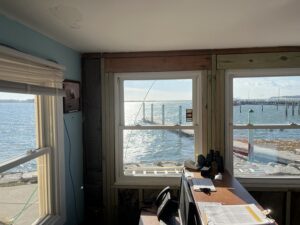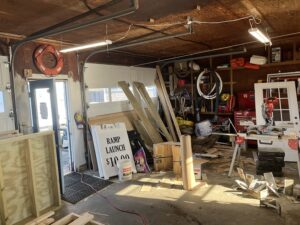WELLFLEET — A Jan. 18 notice from the harbormaster raised eyebrows among shellfishermen here. Winter dockage fees for use of the pier, due on Jan. 31, were being increased dramatically — to more than $1,600 for boats exceeding 26 feet, more than doubling the previous fee of $750.
The new fee schedule included an overnight parking fee of $25 a day.
“Before, we left our boats in the parking lot for $530 all winter,” said Dave Seitler, a former shellfish advisory board member.
A new fee schedule had been approved by the select board on March 12, 2024, but the marina advisory committee thought it involved only a 7-percent increase, according to former member Will Barrio. In January, Seitler and Barrio began hearing complaints from other fishermen who were unaware of the increases until they went to the harbormaster’s office to pay for dockage.
Seitler went to Wellfleet’s new harbormaster, Mike Cavanaugh, to complain. Cavanaugh and his deputy, David Dalby, investigated and determined that the Jan. 18 notice was a mistake. By Jan. 22, it was corrected. Cavanaugh approved a new schedule with a much lower fee: $802 for big boats’ winter dockage, which reflected the agreed-upon 7-percent increase. He also promised to make refunds to fishermen who had already paid the higher amount.
Marina staff also determined that the $25 overnight parking fee applied only to those who do not already pay a launch fee. In that case, 18 hours of free parking is allowed, per state requirements.
“This is unprecedented in Wellfleet,” said Seitler about the quick resolution. “They heard us out.”
Barrio concurred. “I give them the benefit of the doubt, since everyone’s kind of new and figuring it all out,” he said of the new marina leadership. “I’m glad we’re working together.”
Cavanaugh, who started on Nov. 4, 2024, hopes to transform the marina into a safer and more enjoyable place for commercial and recreational users alike. “We walked into somewhat of a mess we’re working on unraveling,” he told the select board on Jan. 22, describing a neglected marina facility and “inconsistencies with collecting fees.”
Cavanaugh also hopes to establish more cordial relations with the marina advisory committee and individual fishermen.
Updates to Infrastructure
Cavanaugh’s plans for the marina are ambitious. This season, apart from the updated fee schedule, he is implementing new guidelines on year-round slip permits, has adjusted dates and dockage prices for the shoulder seasons in November and April, and plans a series of infrastructure upgrades, including renovations to floating docks and the harbormaster’s office, an ice house for shellfishermen’s use, and a fully staffed fuel dock. The dilapidated L-pier, with rusty nails jutting from its wooden surface, will require another round of permitting before the harbor can begin renovations.

Cavanaugh admitted ignorance about the minutiae of the local shellfish market. Though he does not have a background in marina administration or commercial fishing, he is a lifelong recreational boater in Wellfleet and is certified for a captain’s license with towing endorsement. After 27 years in financial management, including stints at Charles Schwab and TD Bank, he applied for the marina position in Wellfleet, where he and his wife had purchased a house.
For now, Cavanaugh’s immediate priorities are infrastructure. “We hope to complete the ice house and repair and put the floating docks back in the water before the season begins,” he said during a recent tour of the marina. “The next step would be fixing the permit fees.”
Barrio said the infrastructure changes would have immediate positive effects on his daily work schedule. Having an ice house on the pier, for instance, would mean he wouldn’t have to drive to Wellfleet Shellfish or a wholesaler to refrigerate shellfish within two hours of harvest.
Seitler, who has both wild-picked and farmed oysters in Wellfleet for more than a decade, hoped that the upgrades could soon include centrally located dockage reserved for commercial unloading. Unlike scallop or clam boat operators, he said, oyster farmers in Wellfleet must load and unload shellfish multiple times a day. He relies on the uncertain availability of the marina’s fixed docks and parking lot. Mooring in the harbor is an unattractive alternative.
Barrio agreed, comparing Wellfleet unfavorably to Chatham, which has more extensive unloading space for oystermen. He’d like to see the return of a rescue boat on the dock, too.
Worries About Fees Continue
While Cavanaugh cut back the most dramatic fee increase, the 7-percent hike was still substantial. When approving that change, the select board had left the base structure and categories of marina fees unchanged.

“We want to simplify this,” Cavanaugh told the Independent. “There’s no rhyme or reason to where this pricing came from.” Eventually, he said, he hopes to adopt a per-foot basis for dockage and then adjust winter fees to a proportionally lower rate. He plans to address summer slip permits and billing in March.
Fishermen who are encouraged by the renewed interest in upgrading infrastructure remain concerned about rising fees. Keith Rose, who lives in Wellfleet and operates the F/V Kimberly Ann, a 50-foot clam boat, is one of the few regular winter users of the troubled L-pier, where taxpayer winter dockage fees increased from $40 per foot in 2021 to $49 per foot in 2024. That adds up, said Rose, considering that the quality of the L-pier has deteriorated over the same period. The comparable rate in Provincetown is $55 per foot.
“I didn’t cause the problems at the pier,” said Rose in Provincetown, where the Kimberly Ann is now docked. “I shouldn’t be more responsible than anybody else for fixing them.”
Barrio noted that the market price for oysters had not kept pace with the rising fees for dockage, permitting, launching, and mooring. His four vessels — a bowtie, a pontoon, a skiff, and another sub-25-foot boat he uses as a mooring dock — were all out of the water, in part due to concerns over increased fees. Aaron Francis, a third-generation oysterman, also noted a stagnant market price of less than 60 cents per oyster in the winter. Francis used to keep his two vessels in the marina’s parking lot in the winter, given a lack of yard space, but had brought one home, partially to avoid fees.
“The price of oysters hasn’t gone up,” Seitler said. “The price of everything else has gone up. There’s not that many of us left. What we really need is dockage and infrastructure and reasonable fees so that we don’t have to operate in a gray area and be stressed out and worried all the time.”



